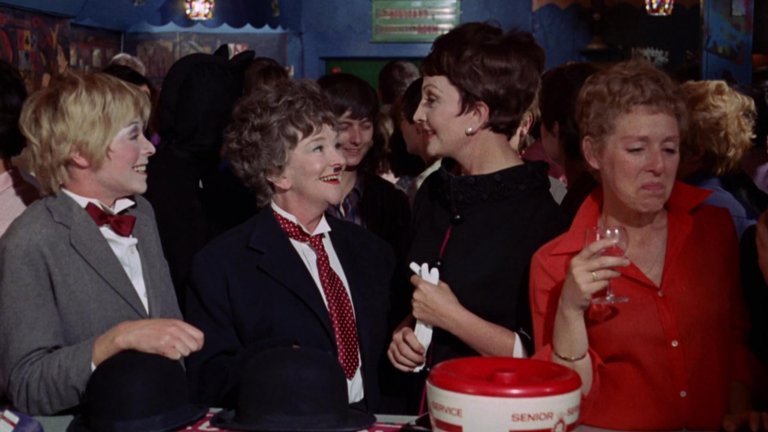Film Review: The Killing of Sister George (1968)

The Swinging Sixties, with London as its cultural epicentre, were defined by a radical shift in social attitudes toward sexuality, particularly the open exploration of alternative forms of desire, including lesbianism. While many films of the era exploited these themes for shock value or titillation, Robert Aldrich’s The Killing of Sister George (1968) stands apart. Unlike its contemporaries, Aldrich’s drama eschewed exploitation in favour of a nuanced character study, anchoring its narrative in the psychological and emotional turmoil of its central figure. Emerging amid the collapse of rigid censorship and the rise of sexual liberation, the film dared to depict lesbianism explicitly, yet its true achievement lies in its unflinching portrayal of a woman’s fractured identity and the corrosive dynamics of power, both personal and institutional.
The film is an adaptation of Frank Marcus’s 1965 stage play of the same name, a work that originally blended dark comedy with sharp satire aimed at the British radio and television industry. Translating this material to the screen, director Robert Aldrich and screenwriter Lukas Heller faced the challenge of balancing the play’s theatrical origins with the demands of cinematic storytelling. The plot revolves around June Buckridge (Beryl Reid), a middle-aged actress whose public persona as “Sister George,” the cheerful, unassuming nurse in a long-running BBC soap opera Applehurst, masks a private life of bitterness, alcoholism, and predatory behaviour. June’s internal conflicts—her resentment toward her fading career, her abusive relationship with her younger lover Alice “Childie” McNaught (Susannah York), and her paranoia over being sidelined by the BBC—form the emotional core of the film.
June’s world unravels as the BBC announces plans to retire her character from Applehurst, a decision she believes is part of a conspiracy orchestrated by the network’s manipulative female executive Mercy Croft (Coral Browne). Meanwhile, her relationship with Alice is revealed as a toxic dynamic built on dominance and humiliation. Alice, a vulnerable and childlike woman, endures June’s physical and psychological abuse while secretly yearning for independence. The arrival of Mercy Croft—a calculating, upper-class figure who takes an interest in Alice—adds a layer of betrayal, as June’s fears about being replaced professionally and personally escalate into a spiral of paranoia and self-destruction.
A hallmark of The Killing of Sister George is its unapologetic depiction of lesbianism, a radical departure from the coded subtextuality of earlier films. The film’s explicitness is evident not only in its scenes at The Gateways, a real-life London lesbian nightclub that operated from 1958 to 1985, but also in its dialogue, which uses previously unspeakable words to describe June and Alice’s orientation. The infamous sex scene between Alice and Croft, featuring Susannah York’s bare breasts, drew the ire of the newly established MPAA ratings board in the U.S., resulting in an “X” rating that stifled the film’s commercial prospects. While this explicitness lent the film historical significance as a document of late-1960s sexual liberation, it also overshadowed its deeper narrative ambitions.
Frank Marcus’s original play was a biting satire of the BBC’s bureaucratic machinations and the commodification of art, themes that are largely diluted in Aldrich’s adaptation. The film’s focus on June’s personal struggles—her alcoholism, her fear of obsolescence, and her toxic relationship with Alice—comes at the expense of exploring the institutional critiques that defined the play’s satirical edge. The dialogue retains a stagy quality, with exchanges that feel overly rehearsed and lacking the naturalism of Aldrich’s more celebrated works like What Ever Happened to Baby Jane? (1962). The pacing, too, suffers from the film’s reliance on theatrical pacing, resulting in an overly drawn-out runtime that dilutes its emotional impact.
Yet, what saves The Killing of Sister George is the extraordinary performances of its lead actors. Beryl Reid’s portrayal of June is a tour de force. Initially repelling audiences with her vitriolic cynicism and cruel treatment of Alice, Reed gradually reveals the vulnerability beneath June’s armour of self-loathing. Her June is a tragic figure, a woman trapped by her own insecurities and societal expectations, whose final breakdown is both harrowing and cathartic. Susannah York, as Alice, delivers a performance of quiet intensity, conveying her character’s innocence and eventual awakening with subtle shifts in expression and posture. Coral Browne, as Mercy Croft, adds a chilling layer of menace, her poised elegance contrasting sharply with June’s disintegration.
Despite its strengths, The Killing of Sister George is far from a flawless work. Aldrich’s direction, while competent, lacks the flair and precision seen in his genre-defining westerns or noir thrillers. The film’s shift away from Marcus’s satirical tone leaves it feeling tonally inconsistent, oscillating between melodrama and bleak naturalism without fully committing to either. The focus on June’s personal demons, while compelling, neglects the rich potential of the BBC’s behind-the-scenes politics, reducing the workplace dynamics to mere plot devices.
Ultimately, The Killing of Sister George is a fascinating, if flawed, artifact of its time. Its explicit portrayal of lesbian desire and its unflinching examination of female agency and power dynamics make it a landmark in late-1960s cinema, even as its narrative and structural weaknesses prevent it from reaching the heights of Aldrich’s best work. For modern audiences, the film offers a window into an era when mainstream cinema began grappling with sexuality’s complexities beyond exploitation—a moment of transition captured with raw, if imperfect, honesty.
RATING: 6/10 (++)
Blog in Croatian https://draxblog.com
Blog in English https://draxreview.wordpress.com/
InLeo blog https://inleo.io/@drax.leo
Hiveonboard: https://hiveonboard.com?ref=drax
InLeo: https://inleo.io/signup?referral=drax.leo
Rising Star game: https://www.risingstargame.com?referrer=drax
1Inch: https://1inch.exchange/#/r/0x83823d8CCB74F828148258BB4457642124b1328e
BTC donations: 1EWxiMiP6iiG9rger3NuUSd6HByaxQWafG
ETH donations: 0xB305F144323b99e6f8b1d66f5D7DE78B498C32A7
BCH donations: qpvxw0jax79lhmvlgcldkzpqanf03r9cjv8y6gtmk9